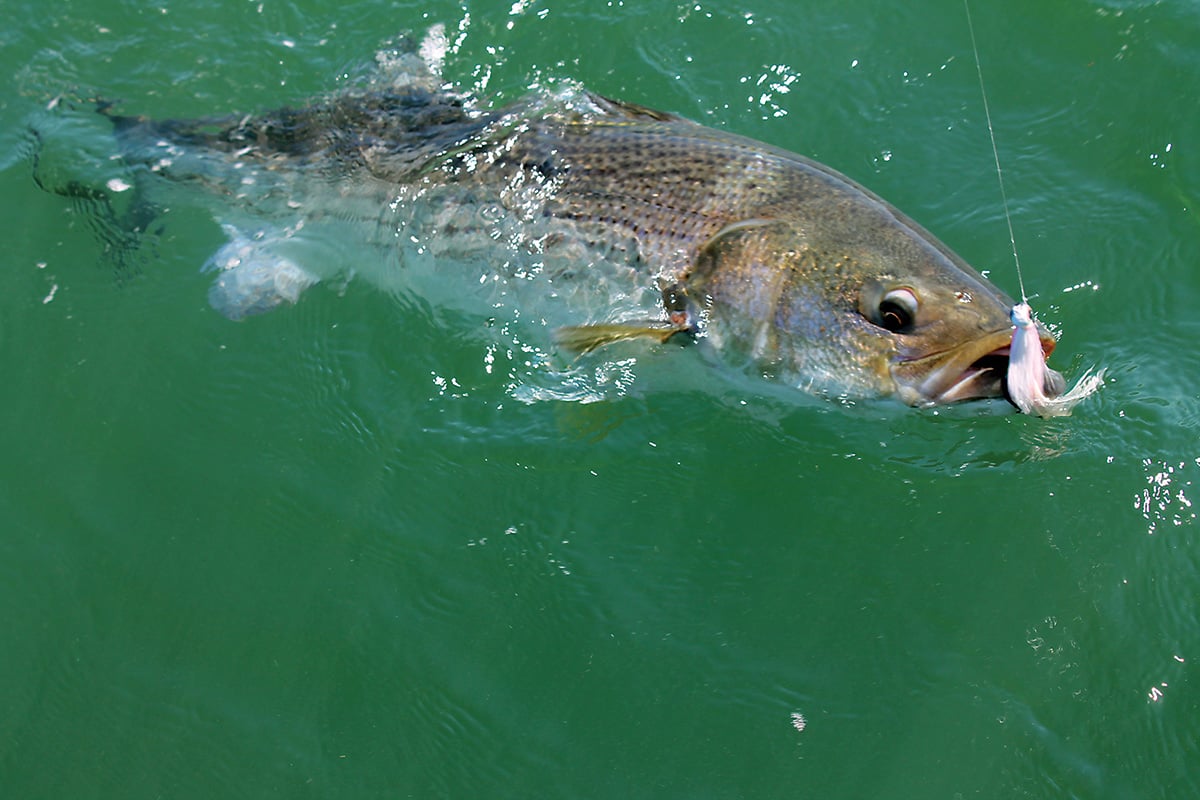
A look at some jig head shapes and how to make them work for you.
My first lesson in “jigging” took place more than 30 years ago when my dad stuck a conventional rod in my hand, pointed me towards the surf and said,” If you lose a few jigs then you’re doing it right. If not, then you’re doing something wrong.” While I will admit that this is probably not the best way to teach a 7-year-old kid how to fish a jig, the words did hold some truth.
As I have learned since that day, there is more to properly fishing a jig than simply keeping it near the bottom. There is so much more to take into consideration including what you choose to adorn the jig, weight of the head, type of hook, color and so on. But when walking into your local tackle shop with as many jigs as lures on the wall, where do you begin? For me the first factor when choosing the proper jig for a given scenario (species, location, fishing style, etc.) is in selecting the correct head style or shape in which the lead is formed around the front of the jig as well as the collar type.
Ball
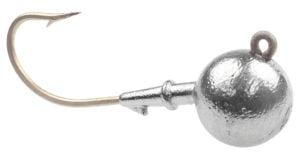 Also referred to as a round-head jig, this is a pretty standard, almost do-it-all jig style. This is a style of jig head that is used in freshwater and salt, shallow water and deep. A ball jig is a fine choice whether you plan to add a rubber tail of some sort or add a live bait. When I used to target smallmouth bass on a river near where I grew up, I always carried round jigs when deploying live shiners or crawfish for weary bronzebacks. In the salt, they work equally well to swim a curly tail, shad body or skinny plastic for a variety of gamefish. With the weight centered at the bend of the hook to the front of the jig, it has a tendency to cast well and sink fast while providing a stable and steady retrieve.
Also referred to as a round-head jig, this is a pretty standard, almost do-it-all jig style. This is a style of jig head that is used in freshwater and salt, shallow water and deep. A ball jig is a fine choice whether you plan to add a rubber tail of some sort or add a live bait. When I used to target smallmouth bass on a river near where I grew up, I always carried round jigs when deploying live shiners or crawfish for weary bronzebacks. In the salt, they work equally well to swim a curly tail, shad body or skinny plastic for a variety of gamefish. With the weight centered at the bend of the hook to the front of the jig, it has a tendency to cast well and sink fast while providing a stable and steady retrieve.
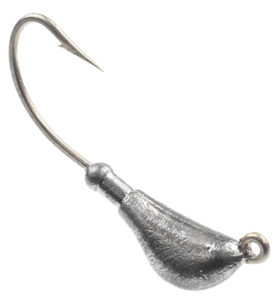 Banana
Banana
The shape of the banana-head jig allows it to be rather easily pulled over and past sticky snags like rocks, and therefore this has become a popular head style for anglers using jigs for blackfish. The weight-forward stance of the jig also allows it to sink heavily nose-first providing an attractive darting action when paired up with a slender, streamlined soft plastic. It is also an excellent choice for applications in which the jig is worked along the bottom in scenarios where a fleeing baitfish motion is sought.
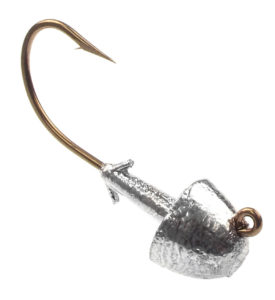 Bullet
Bullet
This head style comes in several variations including extra-elongated noses for added weight. I have seen these jigs in excess of 32 ounces, designed for deep-water cod and halibut hunters. They have also become very popular in recent years by custom bucktail producers crafting extremely productive jigs for striper hunters in both the surf and by boat. The rounded head is relatively good at shedding or rolling over snags, especially important when working over rocky structure. They cut through the water allowing for true swim on the troll or by casting, and they can be adorned with a soft plastic or tied up with natural or artificial fibers of your choice.
Lima Bean
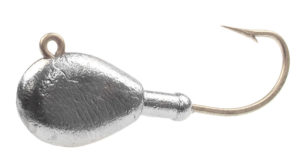 Another head style with different names defining the same shape, I have also seen these referred to as flat-head jigs. The beauty in these heads is that there is little water resistance so it takes slightly less weigh to get down to the bottom than say a wider head style. Due to this, they work extremely well when working deep-water spots both from a boat as well as by shore. I know many old-timers who prefer this style head in places like the Cape Cod Canal and the many breachways and outflows that dot the Striper Coast. This head style has also been very successfully used by tog jiggers. While it does have a tendency to roll onto its side at rest on the bottom, this is more than made up for by its ability to get to the bottom fast without being tossed around by up-welling of a hard-running current.
Another head style with different names defining the same shape, I have also seen these referred to as flat-head jigs. The beauty in these heads is that there is little water resistance so it takes slightly less weigh to get down to the bottom than say a wider head style. Due to this, they work extremely well when working deep-water spots both from a boat as well as by shore. I know many old-timers who prefer this style head in places like the Cape Cod Canal and the many breachways and outflows that dot the Striper Coast. This head style has also been very successfully used by tog jiggers. While it does have a tendency to roll onto its side at rest on the bottom, this is more than made up for by its ability to get to the bottom fast without being tossed around by up-welling of a hard-running current.
Minnow
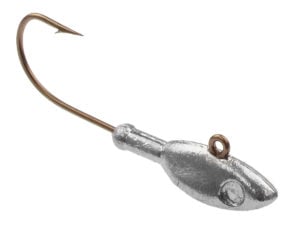 This is a jig head style whose more common name is actually that of one of its most popular commercial producers: Spro. The secret in this style of jig head, which has made it so effective and popular, is in the center balance point. This allows the jig to be vertically jigged, trolled or cast while still retaining the upright orientation. Smaller jigs can be used in freshwater finesse applications under a bobber or over deep water, while saltwater anglers know this jig style as an absolutely deadly jig for the likes of fluke and black sea bass. You can even double-up with a heavy jig used to reach the bottom and a lighter one set up ahead as a teaser. Further, most jig heads produced with minnow-heads feature realistic scales, eyes, gills and other super-realistic features to help seal the deal on wary gamefish.
This is a jig head style whose more common name is actually that of one of its most popular commercial producers: Spro. The secret in this style of jig head, which has made it so effective and popular, is in the center balance point. This allows the jig to be vertically jigged, trolled or cast while still retaining the upright orientation. Smaller jigs can be used in freshwater finesse applications under a bobber or over deep water, while saltwater anglers know this jig style as an absolutely deadly jig for the likes of fluke and black sea bass. You can even double-up with a heavy jig used to reach the bottom and a lighter one set up ahead as a teaser. Further, most jig heads produced with minnow-heads feature realistic scales, eyes, gills and other super-realistic features to help seal the deal on wary gamefish.
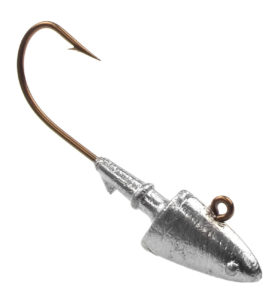 Shad
Shad
This is a very popular jig head style for anglers looking to deliver a soft plastic—especially a shad body—in deep water. The weight-forward, flat-side design produces very little water resistance on the drop so less weight is required to go deep. The flat sides also produce a very stable swim, cutting through the water and allowing the attached soft plastic to work its magic. I like to trim my soft plastics to fit tight up against the back of the jig head for smooth, finished look. Perhaps this is more important to me than it is the fish, but it has served me well for many years.
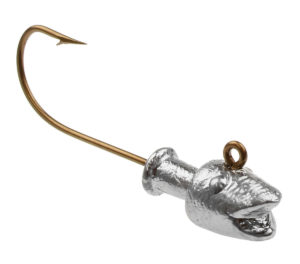 Smilin’ Bill/Hot Lips
Smilin’ Bill/Hot Lips
For years this was THE go-to jig head style for striped bass. Whether deployed on a 3-way rig for deep-water bass holding in a rip or casting from shore into a frothy surf or outflow, an innumerable number of cow bass have been caught on Smilin’ Bills over the years. The “face” of the jig features a wide mouth of sorts, which many feel produces a swimming action not seen in other jigs. This mouth, along with the often-seen protruding eyes can be painted in contrasting colors to the main head for even more realistic, fish-attracting qualities. In general the Smilin’ Bill is tied up with some sort of hair (real or synthetic) on its flared collar to further accentuate the jig’s appeal.
Collar types
While discussing head types, the type of collar featured on a given jig should also be considered. For the most part the type of collars, or the lead where the hook protrudes from the head, are pretty straight-forward in their intended use and application.
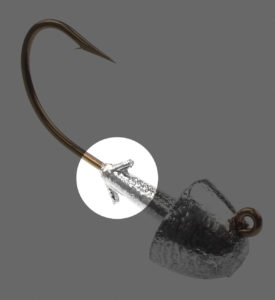 Barbed
Barbed
Generally a barbed collar is preferred when mounting a soft plastic on a jig head. The barb or spike is intended to bite into the rubber and hold it in place. Some jigs feature multiple barbs to further secure the soft plastic.
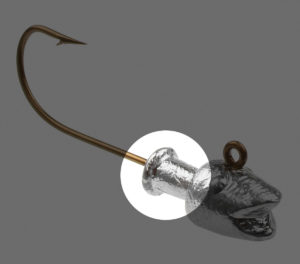 Flared
Flared
A flared collar is generally featured on a jig in which some sort of hair (natural or synthetic) is tied onto the lead head. The gap between head and flare allows for thread to be tied around the hair to secure it to the jig. They are also sometimes used on jig heads intended for eel skins or whole eels.
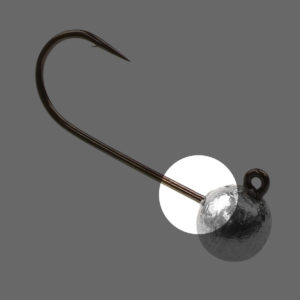 Naked
Naked
A jig head without a collar is generally used in scenarios where a live bait of some sort is pinned on the jig hook. The lack of a collar allows for a cleaner presentation, and some believe the collar can actually get in the way of a solid hook set in a fish’s mouth. Many jigs intended for blackfish feature a reduced or even altogether eliminated collar for this reason. Collar-less jig heads are also used in finesse scenarios where a small amount of hair is tied directly to the hook.
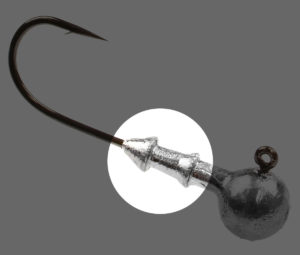 Ringed
Ringed
Much like a barbed collar, a ringed collar is intended for use with soft plastics. On some jigs the ring has a sharp edge towards the nose of the jig to help it bite into the soft plastic, and some jigs feature a sequence of several rings for added bite.




